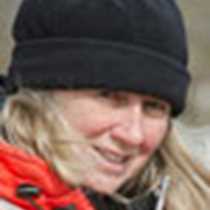Santorini, Greece
Canis major seemed to be tethered to our mast this morning, towing us along in hot pursuit of the hunter Orion. In the darkness the lights of Santorini floated above the sea. Aphrodite's belt, the sign of impeding daylight, was mostly gray with only a hint of pink for the air was dense with humidity. As Apollo's chariot neared the horizon the lights became whitewashed houses draped over the heights like newly fallen snow.
Surrounded by banded cliffs that rise straight to the sky the National Geographic Endeavour drifted to and fro all day long delivering us to destinations and retrieving us once again as we came and went from our island of safety. Our eyes scanned the shores as our bodies pivoted three hundred and sixty degrees. We were surrounded by three islets united in their layering. Minds connected the dots to form a ring. In two dimensions it is a donut but strip the water away by looking at the navigational charts and we discover ourselves enclosed within a bowl, a cauldron, a caldera with a slightly fractured rim. Contained within this urn along with us two dark and sinister newborn islands stand. One still steams and as we walk upon its hot black basaltic crust it sends pungent odors to our nostrils. Our knees might tremble from climbing to its crest and back but they may just as well shake with the knowledge that we are smack dab on top of an extremely tectonically active area. In 1617 BC or so the entire island exploded encrusting remnants of the past in smothering pumice and wiping away the rest in clouds of swirling ash roaring up into the sky 20 miles or more. Giant waves radiated outwards washing away shores as far away as Crete and the Levant. Maybe it will happen again but who knows when? The earth does tremble. Houses fall but life goes on.
Rejuvenated, Oia rose again from the earthquake destruction of the mid 1950's that crumbled seventy percent of its structures. Its youthful countenance is fresh and colorful, the houses clustered together like tussling puppies. Blue domed churches and tiny chapels are as numerous as the families living there, a sure sign of prosperity and a temptation for photographic composition. From the storefronts, the glassy blue backed evil eye keeps watch, maybe providing protection from future geologic destruction.
We will sleep easily tonight. Will it be from exhaustion after a busy day or will it be from relief as we have exited the caldera?
Canis major seemed to be tethered to our mast this morning, towing us along in hot pursuit of the hunter Orion. In the darkness the lights of Santorini floated above the sea. Aphrodite's belt, the sign of impeding daylight, was mostly gray with only a hint of pink for the air was dense with humidity. As Apollo's chariot neared the horizon the lights became whitewashed houses draped over the heights like newly fallen snow.
Surrounded by banded cliffs that rise straight to the sky the National Geographic Endeavour drifted to and fro all day long delivering us to destinations and retrieving us once again as we came and went from our island of safety. Our eyes scanned the shores as our bodies pivoted three hundred and sixty degrees. We were surrounded by three islets united in their layering. Minds connected the dots to form a ring. In two dimensions it is a donut but strip the water away by looking at the navigational charts and we discover ourselves enclosed within a bowl, a cauldron, a caldera with a slightly fractured rim. Contained within this urn along with us two dark and sinister newborn islands stand. One still steams and as we walk upon its hot black basaltic crust it sends pungent odors to our nostrils. Our knees might tremble from climbing to its crest and back but they may just as well shake with the knowledge that we are smack dab on top of an extremely tectonically active area. In 1617 BC or so the entire island exploded encrusting remnants of the past in smothering pumice and wiping away the rest in clouds of swirling ash roaring up into the sky 20 miles or more. Giant waves radiated outwards washing away shores as far away as Crete and the Levant. Maybe it will happen again but who knows when? The earth does tremble. Houses fall but life goes on.
Rejuvenated, Oia rose again from the earthquake destruction of the mid 1950's that crumbled seventy percent of its structures. Its youthful countenance is fresh and colorful, the houses clustered together like tussling puppies. Blue domed churches and tiny chapels are as numerous as the families living there, a sure sign of prosperity and a temptation for photographic composition. From the storefronts, the glassy blue backed evil eye keeps watch, maybe providing protection from future geologic destruction.
We will sleep easily tonight. Will it be from exhaustion after a busy day or will it be from relief as we have exited the caldera?



